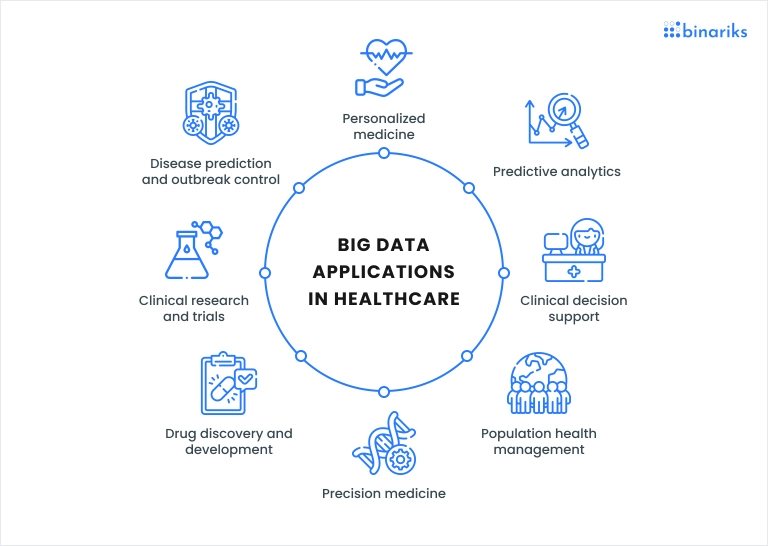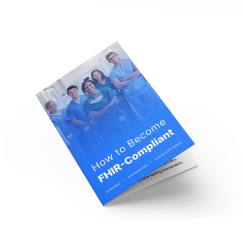Big data in healthcare allows healthcare organizations to optimize their organizational activities and treatment, offering plenty of benefits to patients and healthcare institutions. In this article, we will:
- Explain the advantages of big data in healthcare.
- Dive deep into different big data applications in healthcare, from predictive analytics to disease outbreak control.
- Offer some real-life examples of how big data benefits the healthcare industry, including prominent examples like the Cancer Moonshot program and Mayo Clinic's early use of big data in its organizational activities.
- Analyze current obstacles to using big data in healthcare.
The role of big data in healthcare
The importance of big data in healthcare is unparalleled, even though many healthcare organizations have yet to use big data. Here is how it can help healthcare providers and patients:
Improving patient care
Improving patient care is the key benefit of big data in healthcare. Studies reveal that using big data in healthcare enhances the accuracy of diagnoses (Source ). By analyzing vast datasets from electronic health records (EHRs) , genomics, and wearables, healthcare providers can tailor treatments to individual patient characteristics.
Big data for healthcare also means more accurate diagnoses and improved use of predictive analytics. As a result, patients receive high-quality care at the right time.
Increasing operational efficiency
Big data also plays a crucial role in enhancing the operational efficiency of healthcare organizations. Hospitals can optimize their workflows, reduce wait times, and improve resource allocation by analyzing patterns and trends within the data.
A report by McKinsey estimated that big data could help the U.S. healthcare system save between $300 billion and $450 billion annually by improving operational efficiency (Source ).
Reducing costs
Big data healthcare analytics helps identify inefficiencies and reduce waste, saving healthcare organizations money. For example, predictive analytics can forecast patient admissions, allowing hospitals to allocate resources more effectively and avoid unnecessary expenses.
The same McKinsey report highlights potential savings of 12% to 17% of total healthcare costs through the effective use of big data.
Enhancing patient engagement and satisfaction
Through the use of big data, healthcare providers can offer more personalized patient experiences. This inevitably leads to increased engagement and satisfaction.
- By analyzing patient feedback and interaction data, hospitals can identify areas for improvement and tailor their services to meet patient needs better.
- Better customer engagement and satisfaction results from streamlining hospital processes with the help of big data.
- Wearables are one of the aspects of big data use in healthcare that improves patient engagement.
Using big data to transform healthcare
Big data in the healthcare industry transforms every possible technological innovation, from predictive analytics to personalized medicine. Let's look in more detail into how it transforms the industry.

Personalized medicine
Personalized medicine tailors medical treatment to the individual characteristics of each patient. By analyzing big data sets from genetic information and environmental/ lifestyle factors, healthcare providers can customize treatment plans to improve patient outcomes.
Use cases:
- Genomic sequencing to identify genetic predispositions to diseases and tailor treatments. For example, you can identify genetic mutations responsible for a patient's cancer and select a target therapy based on that.
- Wearable technologies track vital signs and lifestyle habits to inform personalized wellness plans.
Predictive analytics
Predictive analytics use historical and real-time data to forecast future events in healthcare . This approach helps in identifying patients at risk of developing certain conditions. This makes early intervention and consecutive better prognosis possible.
Use cases:
- Predicting patient readmission risks based on electronic health records (EHRs) and social determinants of health. An example would be predicting the risk of diabetes and tailoring specific treatment.
- Forecasting disease outbreaks like COVID-19 by analyzing healthcare data and social media patterns.
- As another illustration, hospitals analyze admission rates and patient data to predict peak times.
Clinical decision support
Clinical decision support systems (CDSS) provide healthcare professionals with knowledge and patient-specific information intelligently filtered or presented at appropriate times to enhance health and healthcare.
Use cases:
- Alerts and reminders for clinicians about potential drug interactions or contraindications based on patient history.
- Diagnostic support tools that suggest possible diagnoses based on patient symptoms and data.
- An AI-powered tool can analyze EHRs in real-time to alert clinicians about patients at risk of sepsis.
Population health management
Population health management involves analyzing data from a broad patient population to improve health outcomes. It focuses on patterns of health determinants and policies and interventions that link them with health outcomes.
Use cases:
- Identifying trends in disease prevalence and healthcare utilization to allocate resources more effectively.
- Developing targeted intervention programs for high-risk populations to reduce the incidence of chronic diseases.
- For example, you can analyze community health data to identify at-risk populations for diabetes.
Precision medicine
Similar to personalized medicine, precision medicine considers individual variability in genes, environment, and lifestyle for each person. It aims to target the right treatments for patients at the right time.
Use cases:
- Cancer treatment plans based on the genetic makeup of the patient's tumor.
- Pharmacogenomics to predict how individuals will respond to medications based on their genetic makeup.
- For instance, you can use genetic information to predict which treatments for diseases like cancer or heart disease will work best for individual patients.
Drug discovery and development
Big data analytics can significantly reduce the time and cost associated with drug discovery and development. Researchers can identify new drug candidates more efficiently by analyzing biological and chemical data.
Use cases:
- Using AI and machine learning to predict how different chemical compounds will interact with targets in the body.
- Analyzing patient data from past clinical trials to identify biomarkers that predict drug efficacy.
- For instance, AI algorithms analyze biological data to uncover novel drug targets for complex diseases like Alzheimer's.
Clinical research and trials
Big data can optimize the design and execution of clinical trials . This includes patient recruitment, monitoring, and outcome analysis.
Use cases:
- Real-world data analysis to identify potential clinical trial participants.
- Adaptive trial designs that evolve based on interim data analysis.
- For example, you can use EHRs to identify patients who meet the criteria for clinical trial enrollment. .
Disease prediction and outbreak control
Leveraging big data analytics can enhance disease surveillance and control efforts. The result is early detection of outbreaks and better preparedness.
Use cases:
- Analyzing travel and health data to predict and contain the spread of infectious diseases.
- Using machine learning models to predict areas at risk for outbreaks based on environmental and population health data.
- Outbreaks like COVID-19 can be predicted based on early social media analysis and search trends.
Unlock your data's potential: discover Binariks' big data and analytics services today!
Modern challenges of healthcare big data
While big data in healthcare is gaining popularity, it is still less popular in health organizations than in many other industries. The challenges discussed in this article segment often become bottlenecks to the broader adoption of big data in the healthcare market.
- HIPAA compliance: Big data for healthcare has to be compliant with HIPAA to protect personal information against data breaches. However, government agencies do not provide companies with a roadmap on how this compliance is supposed to look. Therefore, healthcare organizations are left to their own devices to create a framework to follow HIPPA for big data applications in healthcare.
- Safeguarding patient information: Protecting patient information goes far beyond ensuring HIPAA compliance. Healthcare organizations need a holistic data protection strategy involving cybersecurity measures and staff training on data protection. Cloud is one of the ways that help protect patient information.
- Integration of data from various sources and standardization for seamless data exchange: When using big data in healthcare, you have to combine various data sources, including data from EHRs, lab reports, and many others. In most healthcare organizations, essential data is scattered across multiple departments. Failure to address interoperability challenges can lead to data fragmentation. Cooperation between departments is a step towards successful data integration. Data must be shared, so it is important for organizations to have a data-driven mindset right away. Having a suitable mechanism to collect data surely helps, as does employee training.
Want to become HIPAA-compliant?
FHIR implementation guide

Real-world examples and case studies
Beyond the theory, let's see how researchers and healthcare organizations use big data right now.
1. Real-time alerting and wearables integration
Asthmapolis uses GPS-enabled inhaler trackers to monitor asthma conditions and develop better treatment plans (Source ).
2. Preventing opioid abuse
In collaboration with analytical experts at Fuzzy Logix, Blue Cross Blue Shield has used big data analytics to identify over 700 risk factors for opioid abuse (Source ).
There is still a lot left to be done in this regard as there is no clear framework on how to approach individuals at risk of abuse and actually prevent its occurrence. However, this study represents a step in the right direction.
3. Informed strategic planning for healthcare delivery
The University of Florida utilized Google Maps and public health data to create heat maps for population growth and chronic diseases. This allows for strategic planning in allocating medical services to areas with the highest need (Source ).
4. Big data in cancer research
Cancer Moonshot program is the Obama administration initiative that uses big data for healthcare to track treatment and recovery rates and identify success rates. The goal is to determine the best courses of treatment for different kinds of cancer genomics.
Moonshot is connected to other programs in cancer genomics that rely on big data healthcare analytics (Source ).
5. Predictive analytics for improved patient care
Optum Labs has analyzed EHRs from 30 million patients to create a comprehensive predictive analytics database. Optum now sells these solutions to other healthcare organizations (Source ).
6. Machine learning for heart failure prevention
In one spectacular case, Mount Sinai Health System used machine learning to analyze electronic health records and identify high-risk heart failure patients (Source ). Early intervention reduced hospital readmissions by 20%.
7. Optimizing hospital operations
One of the most innovative healthcare organizations in the United States, Mayo Clinic, leverages the benefits of using big data in healthcare for patient flow data and resource utilization. It also constructs staff schedules based on the reports acquired by leveraging big data.
Big data healthcare analytics identified bottlenecks and inefficiencies in hospital operations. As a result, Mayo Clinic reduced patient wait times and improved staff scheduling. Mayo Clinic pioneered big data analytics in 2014, and it has served as a roadmap for other healthcare organizations in the industry ever since.
Conclusion
From advancing cancer treatments to making hospital operations more efficient, the impact of big data in the healthcare industry is enormous. And just think, big data in the healthcare market is still relatively early in its adoption, with more advancements in the second half of the 2020s.
We forecast that big data and healthcare will focus even more on sharpening predictive analytics tools and personalizing treatments. With the fast development of AI capacities , more and more organizations will lean on real-time data analysis for immediate clinical decision-making to the point of it becoming mainstream worldwide.
For a seamless transformation of your healthcare facility towards big data, you can use the help of a remote IT team that is well-versed in big data in healthcare.
Binariks can help your healthcare organization:
- Develop a big data strategy that aligns with your business goals
- Setting up the necessary infrastructure for big data, such as platforms and databases
- Integrate data from various sources
- Manage data
- Implement analytics tools and algorithms to extract valuable insights from big data
- Ensure compliance with GDPR or HIPAA
- Troubleshooting big data solutions and keeping them up-to-date
FAQ
Share

